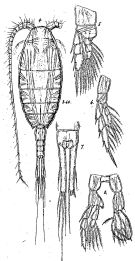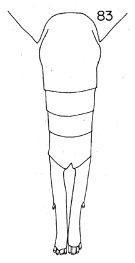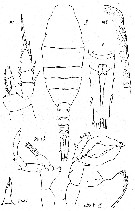|
|
 |
|
Calanoida ( Order ) |
|
|
|
Lucicutiidae ( Family ) |
|
|
|
Lucicutia ( Genus ) |
|
|
| |
Lucicutia intermedia Sars, 1905 (F,M) | |
| | | | | | | Syn.: | Lucicutia philyra A. Scott, 1909 (p.128, figs.F); Sewell, 1948 (p.553); L. tenuicauda : Grice & Hülsemann, 1965 (p.224); ? Lucicutia cf. intermedia Markhaseva & Ferrari, 2005 (p.1098, Rem.) | | | | Ref.: | | | Sars, 1905 c (p.8, Rem.F); 1925 (p.215, figs.F,M); Hülsemann, 1966 (p.721, figs.F,M); Heptner, 1971 (p.131, figs.M); Boxshall & Halsey, 2004 (p.133: F; p.134: M); Vives & Shmeleva, 2007 (p.335, figs.F,M, Rem.) |  Issued from : G.O. Sars in Résult. Camp. Scient. Prince Albert I, 69, pls.1-127 (1924). [Pl.LVIII, figs.4-8]. Female: 4, habitus (dorsal); 5, P1; 6, P5; 7, anal segment and caudal rami (dorsal). Male: 8, P5.
|
 issued from : K. Hülsemann in Bull. Mar. Sc, 1966, 16 (4). [p.720, Fig.83]. Female: 83, urosome (dorsal).
|
 issued from : K. Hülsemann in Bull. Mar. Sc, 1966, 16 (4). [p.726, Fig.113]. Male: 113, P5. R = right leg; L = left leg.
|
 issued from : A. Scott in Siboga-Expedition, 1909, XIX a. [Plate XL, Figs.10-18]. As Lucicutia philyra. Female (from Celebes Sea): 10, habitus (dorsal); 11, forehead (lateral); 12, last thoracic and genital segments (left side); 13, A1; 14, Md (masticatory edge); 15, Mx2; 16, Mxp; 17, P1; 18, P5.
|
 issued from : M.V. Heptner in Trudy. Inst. Okeanol., 1971, 92. [p.131, Fig.28]. Male (from Kuril-Kamchatka Trench). pbs I, spine-like on outer margin of basipod of P1; pbs V, inner distal margin of basis of left P5 with row of spinous processes around inner distal angle.
|
 Lucicutia intermedia Lucicutia intermedia female: 1 - Characters following not combined : Prosome about 3 times longer than urosome. Cephalosome with slightly projecting and rounded anterior corners and well developed lateral spinous projections; anal somite about as long as wide; caudal rami 11.7 times longer than wide and bowed outwards at base, leaving elliptical space between rami proximally. 2 - P1 with 3-segmented endopod. 3 - Cephalosome without spinous projections. 4 - Genital double-somite symmetrical (dorsal view). 5 - Anal somite much shorter than caudal ramus. 6 - P5 with 3-segmented endopod. 7 - Characters not combined between distal 3 to 4 segments of A1 reaching beyond tip of caudal ramus and body length less than 3mm. 8 - Cephalosome without projections. 9 - Terminal setal element of P5 about equal to length of 3rd exopodal segment; body length over 2 mm. 10 - Caudal rami about 7 times longer than wide. Genital double-somite just wider than long.
|
 Lucicutia intermedia Lucicutia intermedia male: 1 - P1 with 3-segmented endopod. 2 - Cephalosome without lateral projections. 3 - Right A1 reaching at most 2 segments beyond tip of caudal rami. 4 - Caudal rami at most 7 times longer than wide. 5 - Inner margin of basis of both P5 without pointed process; endopod of right P5 -2 segmented. . 6 - Caudal rami more than 4 times longer than wide. 7 - Body length more than 2.0 mm. 8 - Basis of left P5 with produced inner distal corner with 3 teeth.
| | | | | Compl. Ref.: | | | Lysholm & al., 1945 (p.35); Sewell, 1948 (p.503); Grice & Hulsemann, 1965 (p.224); 1967 (p.17); Park, 1970 (p.477); Deevey & Brooks, 1977 (p.256, tab.2, Station "S"); Lapernat, 2000 (tabl.3, 4) | | | | NZ: | 6 | | |
|
Distribution map of Lucicutia intermedia by geographical zones
|
| | | | | | | | | | Loc: | | | off NW Cape Verde Is., Canary Is., Madeira, Portugal, E Azores, Bay of Biscay, Caribbean Sea, off Bermuda (Station "S"), Sargasso Sea, W Medit. (off Monaco), Indian, Indonesia-Malaysia (Celebes Sea), ? Kuril-Kamchatka Trench | | | | N: | 11 | | | | Lg.: | | | (1) F: 3,6; (5) F: 3,4; (21) F: 4,1-3,4; M: 3,5 ; (23) M: 4; {F: 3,40-4,10; M: 3,50-4,00}
| | | | Rem.: | bathy-abyssopelagic (1900-3900 m). Sargasso Sea: 500-2000 m (Deevey & Brooks, 1977, Station "S");
Sars (1925) reports this species at station 1991 south of Monaco, but in the text he does not mention its occurrence in the Mediterranean Sea (p.216).
For Hülsemann (1966, p.721) the descriptions which A. Scott (1909) gave for L. phylyra, and Sars (1925) for L. intermedia, agree in all points. Since Sars descibed the species in 1905, his name, L. intermedia, has priority over L. philyra. For Markhaseva & Ferrari (2005, p.1098) although L. intermedia Sars 1905) has not been recorded from Antarctic waters, a form very similar were found south of 56°S and identified as Lucicutia cf. intermedia. Because species of the genus usually exhibit great variability, a series of specimens is needed to determine this variability before the presence of L. intermedia in antarctic waters can be verified. | | | Last update : 16/01/2015 | |
|
|
 Any use of this site for a publication will be mentioned with the following reference : Any use of this site for a publication will be mentioned with the following reference :
Razouls C., Desreumaux N., Kouwenberg J. and de Bovée F., 2005-2025. - Biodiversity of Marine Planktonic Copepods (morphology, geographical distribution and biological data). Sorbonne University, CNRS. Available at http://copepodes.obs-banyuls.fr/en [Accessed August 23, 2025] © copyright 2005-2025 Sorbonne University, CNRS
|
|
 |
 |








